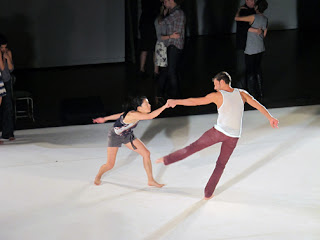The last time I was in Denver, I paid a visit to the Denver Art Museum (DAM) and it made me realize that the mile high city is a lot more sophisticated that Salt Lake City. I was pissed. This trip to DAM did nothing to make me feel any different.
I skipped the blockbuster King Tut exhibit (saw it in San Francisco and it was just OK) and headed straight for the contemporary galleries. And DAM didn't disappoint. A lot has changed since the last time I was there. If MCA Denver is all about ignoring the permanent collection, DAM is about creating an unbelievable permanent collection, much of it modern. And the museum delivers some mighty fine new art.
Much of the contemporary galleries are currently filled with works that explore the human form. It was great to see so many surprising takes on the body, many by some of my favorite artists. Take Marc Quinn's 1999 marble titled Jamie Gillespie. By reminding us of ancient Roman and Greek sculptures missing appendages and yet revered for their physical perfection, Quinn asks us to question our attitudes about those with disabilities.
Tom Friedman wants us to keep our egos in check. His diminutive form crafted from Styrofoam beads reminds us of our insignificance in the grand scheme of the universe.
Exploring our dreams and nightmares are several works by Pia Stadtbaumer including this work, Max, Raven and Scissors (1999, Zellan, scissors and stuffed animal).
Fred Wilson offers his take on the Greek god atlas. Instead of holding up the planet, this version of the god holds up the classic books that define the world's greatest art even though they ignore almost everything outside of Europe and America. To add insult to injury, Atlas stomps on a book about African art. This is Untitled (Atlas), (1992, plaster and books).
It's not just sculpture that explores humanity at the Denver Art Museum. There are some lovely paintings. Take Wes Hempel's Fatherhood (1996, oil on canvas), which is mind blowing for its stunning beauty and art-historical references.
While most of the art is displayed beautifully, there are some questionable decisions. I've been visiting museums for years hoping to see a Marylin Minter painting up close and personal. And for the first time, I encountered one of Minter's strange, realist paintings, Tough Guy (1999, enamel on metal). But it was hung so high on the wall it was impossible to get a good look at Minter's technique. And that's what I've always wanted to get a better look at.
But the contemporary galleries at DAM weren't just about humanity. There was plenty more to explore. I loved Richard Patterson's massive painting Minotaur with Brush Strokes (1998, oil on canvas).
And Sandy Skoglund stops the show with her installation, Fox Games (1989, mixed media). This takes fairy tales and turns them on their heads. It seems the foxes have won. I couldn't help thinking that this says something about our current world; that we've somehow lost control and the foxes and wolves have taken over. Little Red Riding Hood is in big trouble.
At most museums, I hit the contemporary galleries and head to my next adventure. But Felix suggested we visit the photography galleries. Who knew, there's a lot of stuff to see in art museums outside of the contemporary galleries. There's a brilliant photography show currently up at DAM called Exposure: Photos from the Vault. There are some amazing photographs including a brilliant self portrait of Chuck Close. But my pick of the show was Berenice Abbott's strange and dreamy Designer's Window, Bleeker Street (1947, gelatin silver print).
And in the galleries devoted to Mexican art we ran across this stunning bit of old-world painting designed to help define the classes. Franisco Clapera's Castas Paintings (about 1775, oil on canvas) were part of a supposedly common practice. These types of painting attempted to showcase and categorize the various racial mixes occurring at the time. Artists usually made these paintings in sets that showed fourteen to sixteen possible combinations, helping to define social distinctions.


















































